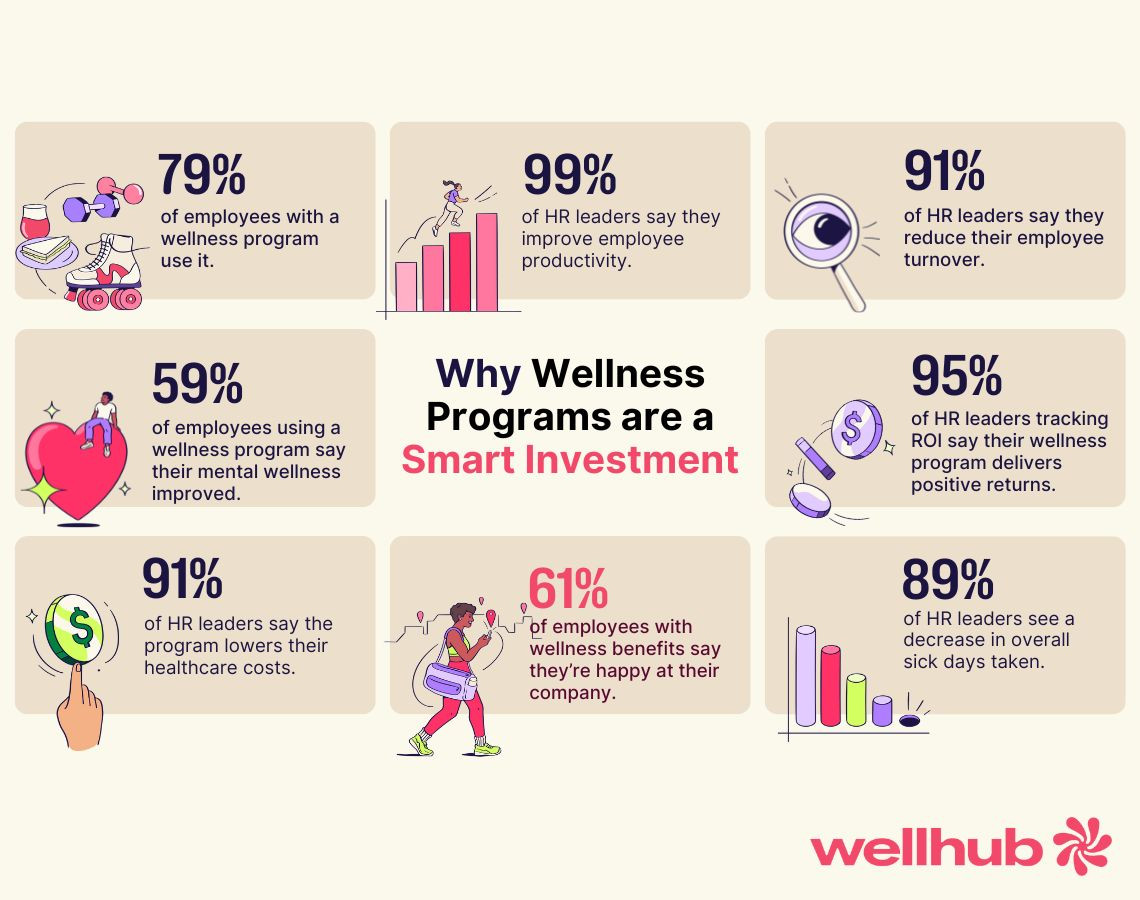Benefits of Employee Wellness Programs: Boost Profitability & Retention
Last Updated Jun 2, 2025

HR leaders are under pressure to do more with less: retain talent, boost performance, and cut costs without burning out teams. But stress levels are rising, sick days are adding up, and turnover is getting more expensive by the quarter.
This is more than frustrating. It’s unsustainable.
That’s where a strategic wellness program comes in. These are a powerful way to improve productivity, lower healthcare costs, reduce turnover, and increase employee happiness. And it’s working: Over 95% of HR leaders who measure ROI say their wellness programs are delivering positive returns.
Unlock the secrets to building a healthier, more engaged workforce—and see why the smartest HR teams are betting big on wellbeing.

Why Wellness Programs Are a Smart Investment
Numbers talk, so give these stats a hard listen.
The Quantifiable Business ROI of Wellness
Wellness programs work. Plain and simple. In fact, 95% of HR leaders tracking ROI report positive returns from their wellbeing programs. These aren’t just minor improvements. A full 56% of companies report getting more than $2 back for every $1 spent. That’s a return any CFO would love.
And where are those returns coming from?
- Productivity: 99% of HR leaders say wellness programs improve employee productivity, with nearly half seeing major improvements.
- Turnover: 98% say these programs reduce turnover—helping retain talent in a tight labor market.
- Absenteeism: 89% report a decrease in sick days.
- Healthcare savings: 91% of companies say wellness programs lower healthcare costs.

Engagement Drives Improvements
Thank high engagement rates for high ROI. Benefits only work when people use them, and, fortunately, 79% of employees with a wellness program actually use it. It’s no wonder why, as employees who engage with their program are:
- Nearly twice as likely to get quality sleep
- 59% more likely to report improved mental wellness over the past year
- 47% more likely to say they eat a good diet
- And they’re happier: 61% of workers with wellness benefits say they’re happy at their company, compared to only 36% of those without.
How Wellness Programs Strengthen Physical and Mental Wellbeing
Wellness programs are one of the most powerful tools HR leaders can use to support a thriving workforce. They're not just about access to fitness classes or meditation apps—though those matter too. They're about helping people feel better, function better, and work better across every dimension of their health.
Let’s break that down.
Physical Benefits: Helping Employees Feel Strong, Energized, and Well
Physical health is the foundation of sustainable performance. When employees feel good in their bodies, everything from focus to mood to motivation improves. Here’s how wellness programs move the needle on physical wellbeing:
Improved Sleep Quality
Sleep is where physical and emotional recovery happens. But most workers aren’t getting enough of it.
- Only 32% of employees say they have healthy sleep, according to the State of Work-Life Wellness 2025 report.
- Employees with wellness programs are nearly twice as likely to report quality sleep compared to those without (39% vs. 21%).
By supporting better rest—through mindfulness tools, physical activity, and stress relief—wellness programs give teams the recharge they need.

Increased Physical Activity
Exercise doesn’t just boost strength—it improves mood, reduces stress, and enhances cognitive function.
- Nearly half (48%) of Wellhub users exercise daily, compared to just 31% of those without access.
- Among employees with Wellhub, 63% say they’re in good physical shape, compared to just 33% of those without.
Whether it's in-person workouts or digital fitness platforms, having diverse ways to move makes it easier for employees to stick with healthy habits.
Healthier Nutrition Habits
Nutrition fuels everything—from energy levels to mental clarity to immune strength.
- Employees with wellness programs are significantly more likely to say they eat a good diet (47% vs. 29%).
- Workers without programs are twice as likely to have a poor diet.
With access to nutritional coaching, meal tracking tools, and education, wellness programs help employees make sustainable, healthy choices.
Mental Benefits: Building Resilience, Reducing Stress, and Supporting Emotional Health
Mental wellness is no longer a soft metric—it’s a core business driver. Employees today need support that helps them feel focused, calm, and connected.
Stronger Mental Wellness Outcomes
When employees have access to support, their mental wellbeing improves—plain and simple.
- 59% of employees with a wellness program say their mental health improved over the last year, compared to 36% without one.
- Among Wellhub users, that number rises to 75%.
That’s a powerful case for integrating mental health tools directly into your employee benefits stack.
More Mindfulness, Less Stress
Regular mindfulness practice is one of the most effective ways to build emotional resilience and reduce stress, two of the biggest issues in the workplace today.
- 47% of employees say work stress is degrading their mental wellbeing, making it the leading cause of emotional strain.
- Employees who practice mindfulness more often are more likely to report doing well physically and mentally.
Tools like guided meditations, breathwork classes, and personalized coaching help employees recenter and recharge, even during the busiest workdays.
Higher Emotional Satisfaction at Work
Mental wellbeing doesn't just influence how people feel—it shapes how they engage.
- 61% of employees with wellness programs say they’re happy at their company, compared to 36% without.
- 79% believe HR genuinely cares about their wellbeing when a wellness program is in place, versus just 45% without one.
This emotional connection leads to higher trust, stronger engagement, and better retention.
Business Benefits of a Wellness Program: Engagement, Retention, and ROI
Wellness programs are a strategic win for your entire organization. When employees feel healthier and more supported, their performance improves. Absenteeism drops. Turnover slows. Engagement grows. And your company sees a measurable return on its investment.
Let’s explore how.
Better Employee Engagement
Employee engagement is the heartbeat of productivity. And wellbeing is a direct line to improving it.
Higher Happiness, Higher Output
When employees feel good, they do great work.
- 61% of workers with a wellness program say they’re happy at their company, compared to just 36% of employees without one.
- 79% say they believe HR genuinely cares when a wellness benefit is offered, which builds trust and loyalty across the org.
A happier workforce is a more productive one—and that matters to your bottom line.
More Self-Care, More Output
Wellness programs also fuel daily participation and presence, and engagement is a performance multiplier.
- Wellhub users are more likely to say they have time to care for themselves—57% vs. just 27% of non-users.
This support translates to higher energy, better focus, and fewer off days.
Improved Talent Management
Burnout, stress, and unmet wellbeing needs are some of the top drivers of attrition today. A proactive wellness strategy can reverse that trend.
Lower Turnover
Turnover is expensive. But with the right wellness program, much of it is avoidable.
- 98% of HR leaders say their wellness program reduces turnover.
- Among younger generations, Gen Z and Millennials are significantly more likely to leave companies that don’t prioritize wellbeing.
The message is clear: if you don’t invest in wellness, someone else will—and your talent will follow.
Better Retention
Today’s employees are actively comparing benefits—and they’re willing to walk for better ones.
- 55% of employees say they would consider switching jobs for a better benefits package.
- When wellness is part of the mix, employees rate their benefits 2x more positively (70% positive rating with wellness vs. 36% without).
It’s clear: Wellness is a key part of your retention strategy.
The Financial Returns of Employee Benefit Programs
Wellness programs are a high-leverage investment. They don’t just pay for themselves—they generate real value across the organization.
Lower Healthcare and Absenteeism Costs
Healthier employees use fewer sick days and fewer healthcare dollars.
- 91% of companies say their wellness program helps reduce healthcare costs.
- 89% see a drop in employee sick days, and 13% say average sick days dropped by at least one full workweek per year.
The right wellness investment today can reduce healthcare claims tomorrow.

Tangible ROI and Cost Savings
The return on wellness is visible and measurable.
- 95% of HR leaders tracking ROI say their wellness program delivers positive returns.
- 56% report an ROI over 100%, meaning they get more than $2 back for every $1 spent.
These returns come from multiple sources: lower healthcare costs, reduced absenteeism, and improved productivity.
Boosted Performance and Productivity
At the end of the day, wellness is a performance driver.
- Personal and family health problems cause annual productivity losses of $1,685 per employee per year, totalling $225.8 billion in missed output annually, according to the CDC.
- Fortunately, 99% of HR leaders say their program improves employee productivity, with nearly half reporting major improvements.
These productivity gains come from fewer distractions, better energy, and more focused, motivated teams.

What Makes a Great Wellness Program?
Not all wellness programs are created equal. The best ones go beyond surface-level perks to deliver real, measurable impact across physical, mental, emotional, and financial wellbeing. They offer flexibility, personalization, and support—meeting employees where they are, and helping them get where they want to go.
Let’s take a look at what separates good from great.
Holistic Support Across Every Area of Life
A great wellness program addresses the full spectrum of employee health—not just physical fitness. That means including resources that support the mind, body, and wallet.
Meditation and Mindfulness
Mindfulness tools help employees manage stress, build resilience, and stay focused at work. Employees who practice mindfulness regularly report better mental and physical wellbeing. Apps like Headspace offer guided meditations, breathing exercises, and emotional check-ins that can be done anytime, anywhere. This kind of support helps employees pause, reset, and re-engage—even in high-pressure environments.
Sleep Health and Tracking
Sleep is one of the biggest drivers of productivity and recovery, and most workers aren’t getting enough: Only 32% of employees report having healthy sleep habits.
Wellness programs that prioritize sleep help employees show up fully rested and mentally sharp. Tools like sleep tracking apps, meditation apps, and sleep hygiene workshops can make a big difference.
Financial Wellness Support
Money stress is work stress: 68% of employees say their financial situation is preventing them from investing in their health.
Financial wellbeing programs give employees the tools to breathe easier. Great programs include budgeting tools, debt management resources, student loan counseling, and retirement planning support. When employees feel financially secure, they’re more present, focused, and engaged at work.
Built-In Flexibility and Personalization
A winning wellness program doesn’t take a one-size-fits-all approach. It offers choices and customization, empowering employees to engage in ways that work for them.
On-Demand and Digital Tools
Employees are busy. On-demand access removes barriers to participation. Whether it’s a midday yoga class, an evening workout, or a quick meditation between meetings, employees can plug in when it fits their schedule.
Wellhub’s platform includes thousands of gyms, apps, and digital coaching options, all accessible through a single subscription. This kind of flexibility drives real engagement—because employees can use it on their terms.
1:1 Coaching and Support
Sometimes, employees need personalized guidance—not just resources. Great programs offer access to certified wellness coaches, mental health counselors, and fitness trainers who can work with employees one-on-one. Support like this turns passive participation into sustained progress. Individual coaching access, like the kind included in Wellhub, helps employees set and stick to meaningful goals.
Clear Communication and Strong Leadership Buy-In
Even the best wellness program won’t work if employees don’t know it exists, or don’t feel empowered to use it.
Transparent Communication
Employees need to understand what’s available, how to access it, and why it matters. Clarity builds confidence. And confidence builds engagement.
The most successful companies integrate wellness into onboarding, performance reviews, and team meetings. They also use dashboards and regular updates to track participation and celebrate progress.
C-Suite Commitment
When leaders walk the talk, employees are more likely to follow. Higher rates of C-suite participation correlate with higher employee engagement in wellness programs. Leadership messaging should consistently reinforce that wellbeing is more than just allowed—it’s encouraged. That type of top-down support transforms a wellness program from a perk into part of the culture.
Wellness Programs Are the Smartest Investment You Can Make in Your People
Wellness programs don’t just check a box—they solve real business problems. If your team struggles with burnout, absenteeism, low engagement, or rising healthcare costs, this post made it clear: a wellness program directly addresses each of these challenges.
The data speaks volumes. Companies with wellness programs see reduced sick days, improved employee happiness, and retention gains of up to 40%. Nearly 80% of employees with access to a program actually use it—and when they do, they sleep better, eat better, and show up as their best selves at work.
A comprehensive, flexible wellness platform like Wellhub meets employees wherever they are in their journey. It helps you drive performance, retain talent, and build a culture of care that fuels long-term success.
Speak with a Wellhub wellbeing specialist to turn today’s workforce challenges into tomorrow’s performance breakthroughs.

Company healthcare costs drop by up to 35% with Wellhub*
See how we can help you reduce your healthcare spending.
References
- Wellhub (2024, May 16). Return on Wellbeing 2024. https://wellhub.com/en-us/resources/research/return-on-wellbeing-2024/
- Wellhub (2024, October 16). The State of Work-Life Wellness 2025. https://wellhub.com/en-us/resources/research/work-life-wellness-report-2025/
- Worker Productivity Measures. (May 17, 2021). Centers for Disease Control and Prevention. Retrieved November 25, 2022 from https://www.cdc.gov/workplacehealthpromotion/model/evaluation/productivity.html.
Category
Share

The Wellhub Editorial Team empowers HR leaders to support worker wellbeing. Our original research, trend analyses, and helpful how-tos provide the tools they need to improve workforce wellness in today's fast-shifting professional landscape.
Subscribe
Our weekly newsletter is your source of education and inspiration to help you create a corporate wellness program that actually matters.
Subscribe
Our weekly newsletter is your source of education and inspiration to help you create a corporate wellness program that actually matters.
You May Also Like

Corporate Wellness Trends HR Must Know for 2026 | Wellhub
See the top 2026 wellness trends shaping performance, retention, and culture—plus how HR can build a unified, ROI-driven wellbeing strategy.

Wellness Points Programs: Boost Employee Health & Engagement | Wellhub
Turn your workplace wellness strategy around with a points program that rewards healthy behavior with perks, from extra time off to gift cards.

Employee Financial Wellness Programs: Ultimate HR Guide | Wellhub
Create an effective financial wellness program that supports your employees in their financial needs, boosting productivity and retention.